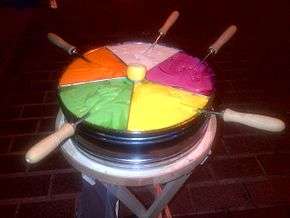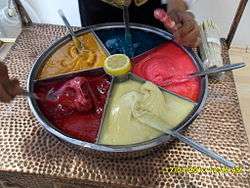Macun
Macun (in Turkish also Macun şekeri) is a soft, sweet and colorful Turkish toffee paste.[1][2] It is a street food that may be prepared with many herbs and spices. Macun originated from spicy preparations of Mesir macunu,[3] a traditional Turkish herbal paste from the classical antiquity period. During classical antiquity, macun was consumed as a pharmaceutical medicine. It was historically served in a round tray with separate compartments for the various flavors, a serving style that has continued into modern times. The consumption of macun is a part of some Turkish customs.

Overview

Macun is a street food that is often sold outdoors,[1] especially during street festivals (panayır). It is a popular sweet among children.[1] The color of various macuns may be vivid or bright.[2] Macun may be prepared with a great deal of herbs and spices.[4] Ingredients to flavor macun have traditionally included bergamot, cinnamon, mastic, mint, rose, lemon and plum.[1]
History
Macun originated from spicy preparations of Mesir macunu,[3] a traditional herbal paste from classical antiquity.[1] During classical antiquity, macun was consumed as a pharmaceutical medicine.[1]
Macun was purported to have therapeutic effects to give the body strength and to calm one's spirit.[1] Islamic physicians have prepared hundreds of different varieties of macun.[1] The various herbs and spices used were mixed with honey in macun preparation, the latter of which also served to preserve the product.[1] Various macuns have been served and consumed as both a medicine and as a confectionery (sweetmeats).[1] During the Ottoman period, macun named Neruz macunu, also referred to as nevruziyye, was consumed as both a medicine and confectionery.[1]
During the 17th century in Turkey, the dervish Seyyid Hasan denoted the consumption of two flavors of macun, respectively flavored with mint and sweet flag.[1] These macun varieties were served at meals he consumed with other dervishes and friends.[1] Hasan was a part of the Sunbuliyye mystic order, as its sheikh.[1]
Service

Macun is typically served in a round tin tray that has separate triangular-shaped compartments.[1] It may be served by scooping using a macuncu mablaği or macunkeș, which is shaped like a screwdriver.[1] The macun is scooped and then wrapped around a small stick.[1][2] This may be done with alternate flavors, which creates a striped sweet.[1] In Turkey, people that serve macun may be referred to as macuncu.[1]
History
In the past in Turkey, the serving trays were constructed from copper or wood, and street vendors would stand the macun trays upon portable tripods.[1] Others would carry macun in a container strapped to their waist with a belt, whereby the container had separate compartments for various flavors of the macun.[1] Some macun vendors in Istanbul, Turkey, would try to attract customers and compete with other vendors by playing music.[1] Street vendors would purvey macun to people at the Hıdırellez spring festival, on market days, holidays, at wedding processions,[1] and at other times.
Customs
In the Anatolia region, it is a wedding custom for the groom to eat macun on the night of his wedding.[4] The mesir bayrami ceremony in Manisa, Turkey, involves the distribution of macun to people on the streets.[4]
References
- Isin, M. (2013). Sherbet and Spice: The Complete Story of Turkish Sweets and Desserts. I. B. Tauris. pp. 86–90. ISBN 978-1-84885-898-5.
- Goldstein, D.; Mintz, S. (2015). The Oxford Companion to Sugar and Sweets. Oxford University Press. p. 1290. ISBN 978-0-19-931362-4.
- "The Turkish sweet tooth". DailySabah. November 24, 2014. Retrieved December 27, 2015.
- Önen, Ü. (1991). Turkey. Akademia Yayıncılık. p. 65. (subscription required)
Further reading
- "Şişli'de iftar vakti". Cumhuriyet Gazetesi (in Turkish). June 22, 2015. Retrieved December 27, 2015.